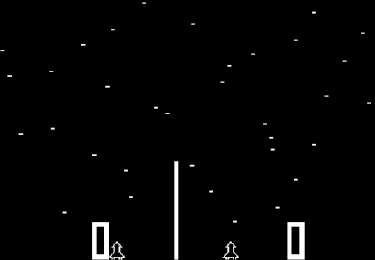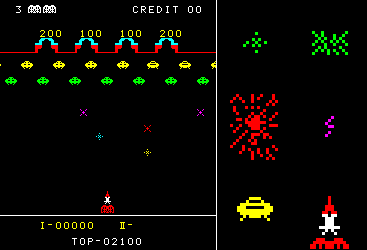Shooter Gallery #3: Frogger in Space
Not all video game successes have a lasting impact. The games I'm going to talk about here were part of a very brief wave of "crossing" shooters that hit arcades only in 1979. The formula, which I describe below, would be abandoned by the beginning of the next calendar year, but it was popular enough in its time that it was widely cloned, bootlegged, and improved upon during its short lifetime.
Space Race is a two-player game and there's nothing at the top of the playing field, so it's not exactly the same, but the space theme and the horizontally moving asteroids are there.
Galaxy Wars, meanwhile, bears the marks of a post-Space Invaders game -- the UFOs look similar speed up as their numbers dwindle. However, the gameplay is very different from Space Invaders. You could even make the argument that Galaxy Wars is not a shooter, given that you're not firing at anything (rather, you're the bullet). Perhaps the best classic gaming comparison is Konami's Frogger, where a lone frog attempts to cross between horizontally moving obstacles from one side of the screen to the other.
It's not difficult to see why Galaxy Wars failed the test of time. The game is frustratingly static, and the gradual destruction of the UFOs does little to change the flow. The asteroid field is too sparse and slow for pattern recognition to be useful and the speed-up of the UFOs is not enough of a game-changer to build tension. Developers of the time may have recognized these problems and tried to improve on it in the games that follow.*
* I cannot confirm the release dates with anything official, but IMDb lists August for Galaxy Wars, Giant Bomb has November for Space Launcher, and Gaming History gives a November release date for Lunar Rescue.
Nintendo's take on the crossing shooter looks very similar to Galaxy Wars at first blush, but includes a key addition: there are now docks at the top of the screen. This not only gives the player a second launching point from which they can traverse the field, but also give them a secondary goal. Each dock is worth a different number of points, incentivizing the player to explore more of the playing field and dock at the location with the highest point yield. Also, it's no longer a one-way trip -- the rocket occasionally develops a force field on its nose that destroys the UFOs on contact, but leaves the rocket intact.
The overall experience is more engaging than Galaxy Wars, but could use some polish. The biggest problem is the force field at the tip of the rocket, which appears out of nowhere when the player reaches a certain part of the screen. It probably would have helped to give the player control of this feature. Also, the docks are so close to the UFOs that the return trip feels extraneous, mostly adding dead time to the game.
Galaxy Wars
The late ‘70s were a wild time for arcade games, particularly in Japan. When one company came up with a successful formula, others would reverse engineer the cabinet and release the same game under their own name. There was so much illicit copying during this period (including by the Yakuza) that it's not clear whether Taito or Universal originally released Galaxy Wars.
Regardless, the game follows a simple formula. The player, who controls a rocket at the bottom of the screen, launches upwards and tries to collide with UFOs at the top of the screen. All the while, their progress is impeded by horizontally moving asteroids and vertical shots from the UFOs.
The idea isn't totally original. In fact, it goes back at least as far as 1973, when Atari released a game called Space Race.Regardless, the game follows a simple formula. The player, who controls a rocket at the bottom of the screen, launches upwards and tries to collide with UFOs at the top of the screen. All the while, their progress is impeded by horizontally moving asteroids and vertical shots from the UFOs.
Space Race is a two-player game and there's nothing at the top of the playing field, so it's not exactly the same, but the space theme and the horizontally moving asteroids are there.
Galaxy Wars, meanwhile, bears the marks of a post-Space Invaders game -- the UFOs look similar speed up as their numbers dwindle. However, the gameplay is very different from Space Invaders. You could even make the argument that Galaxy Wars is not a shooter, given that you're not firing at anything (rather, you're the bullet). Perhaps the best classic gaming comparison is Konami's Frogger, where a lone frog attempts to cross between horizontally moving obstacles from one side of the screen to the other.
It's not difficult to see why Galaxy Wars failed the test of time. The game is frustratingly static, and the gradual destruction of the UFOs does little to change the flow. The asteroid field is too sparse and slow for pattern recognition to be useful and the speed-up of the UFOs is not enough of a game-changer to build tension. Developers of the time may have recognized these problems and tried to improve on it in the games that follow.*
* I cannot confirm the release dates with anything official, but IMDb lists August for Galaxy Wars, Giant Bomb has November for Space Launcher, and Gaming History gives a November release date for Lunar Rescue.
Space Launcher
The overall experience is more engaging than Galaxy Wars, but could use some polish. The biggest problem is the force field at the tip of the rocket, which appears out of nowhere when the player reaches a certain part of the screen. It probably would have helped to give the player control of this feature. Also, the docks are so close to the UFOs that the return trip feels extraneous, mostly adding dead time to the game.
Lunar Rescue
Even if the attribution of Galaxy Wars is uncertain, there seems to be no dispute about Taito's ownership of Lunar Rescue. In this variant of the crossing shooter, the playing field is turned upside down, with the player starting at the top and "docking" on landing platforms on the bottom. It also borrows liberally from Atari's Lunar Lander with both the theme and landing mechanics.
The docks are given different point values, just as in Space Launcher, but this time they serve the additional purpose of rescuing people from the lunar surface. In the descent, your ship dodges asteroids, just as in the other games. On the way up, however, the asteroids are replaced with alien ships, which you can shoot to clear the path.
The repurposing of the alien ships is clever and gives the game a more rounded feel. Most importantly, it plugs a hole in the gameplay, with both ascent and descent now carrying equal weight in the experience. As you progress, the game begins tossing fireballs at you, adding challenge and depth.
Lunar Rescue is easily the most fun of the three crossing shooters from 1979, but it may also have convinced developers that they'd hit a ceiling in what they could do with this formula. For all of its bells and whistles, Lunar Rescue still feels slow-paced and shallow compared to the best shooters from the period. Using one button to dodge asteroids moving in one dimension couldn't have been very satisfying to arcade-goers who had cut their teeth on the more realistic physics and complex controls that Asteroids and Lunar Lander had to offer.
I haven't encountered any crossing shooters from 1980 or 1981, so this must have been a short branch in the tree that sprouted from Space Invaders. Three years later, Frogger would create a national craze using a similar formula, but in an entirely different context. One wonders if further development of this class of shooters would have eventually led to a breakthrough.
Space Beam
This last game is not really a crossing shooter, but came out in the same year and is clearly a close relative.
 |
| Note that the colors in the original game may differ from what's shown here. |
Space Beam pits two players, or one player and an AI, against each other in a gun-fight-like scenario. Each player controls a beam that they try to shoot between "asteroids" to hit their opponent. The players' laser beams are constantly charging and must reach a certain level of charge before they can travel far enough to hit the other player.
This particular game is by Irem, but there are several very similar ones that were produced around the same time and it's not clear which was the first. Regardless, there is not much here to take credit for -- it's not substantially different from the other player-vs-player games that were produced in the '70s.




Space Beam (or its other variants) must have been the inspiration for Atari's Demons to Diamonds.
ReplyDelete